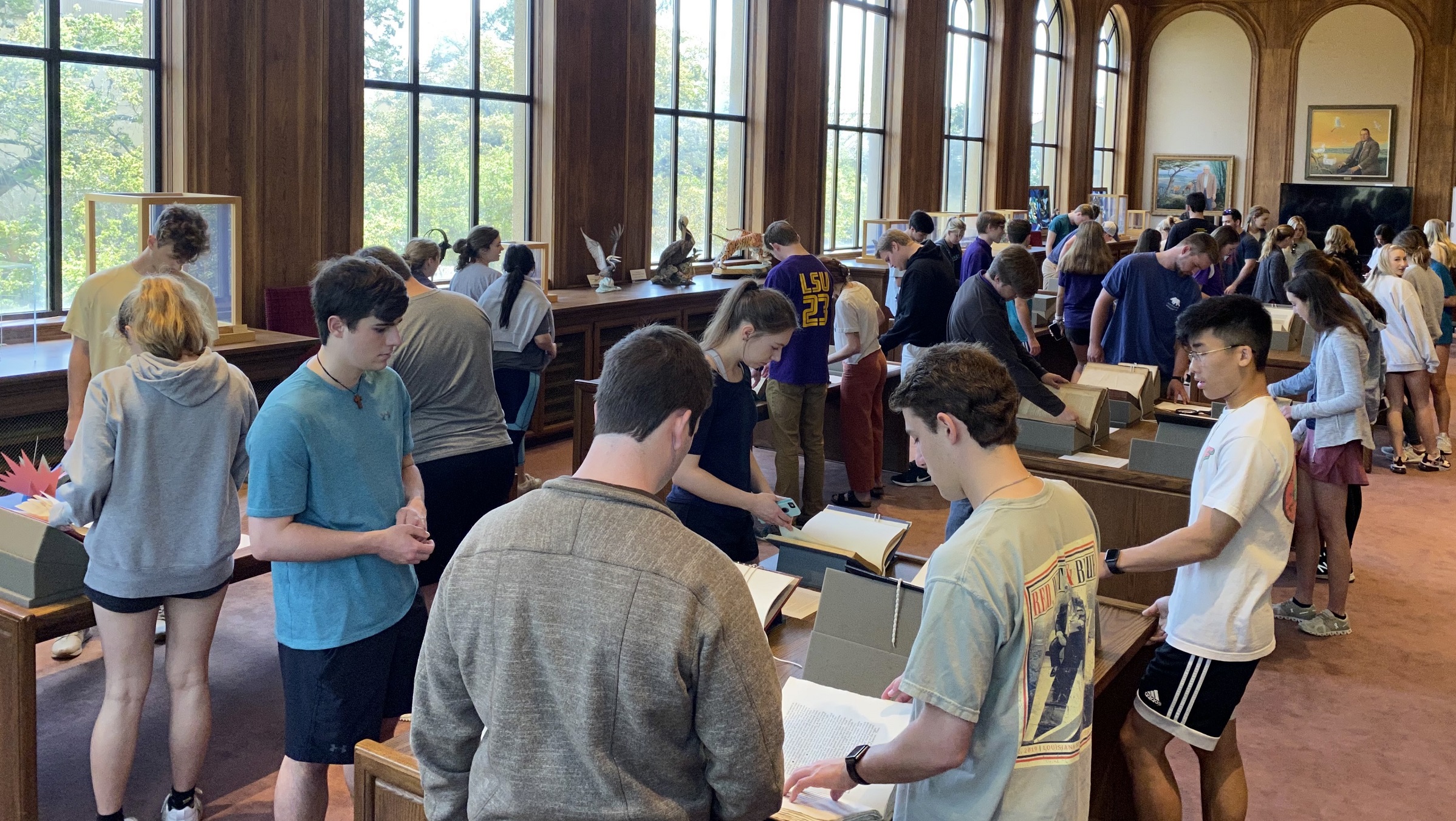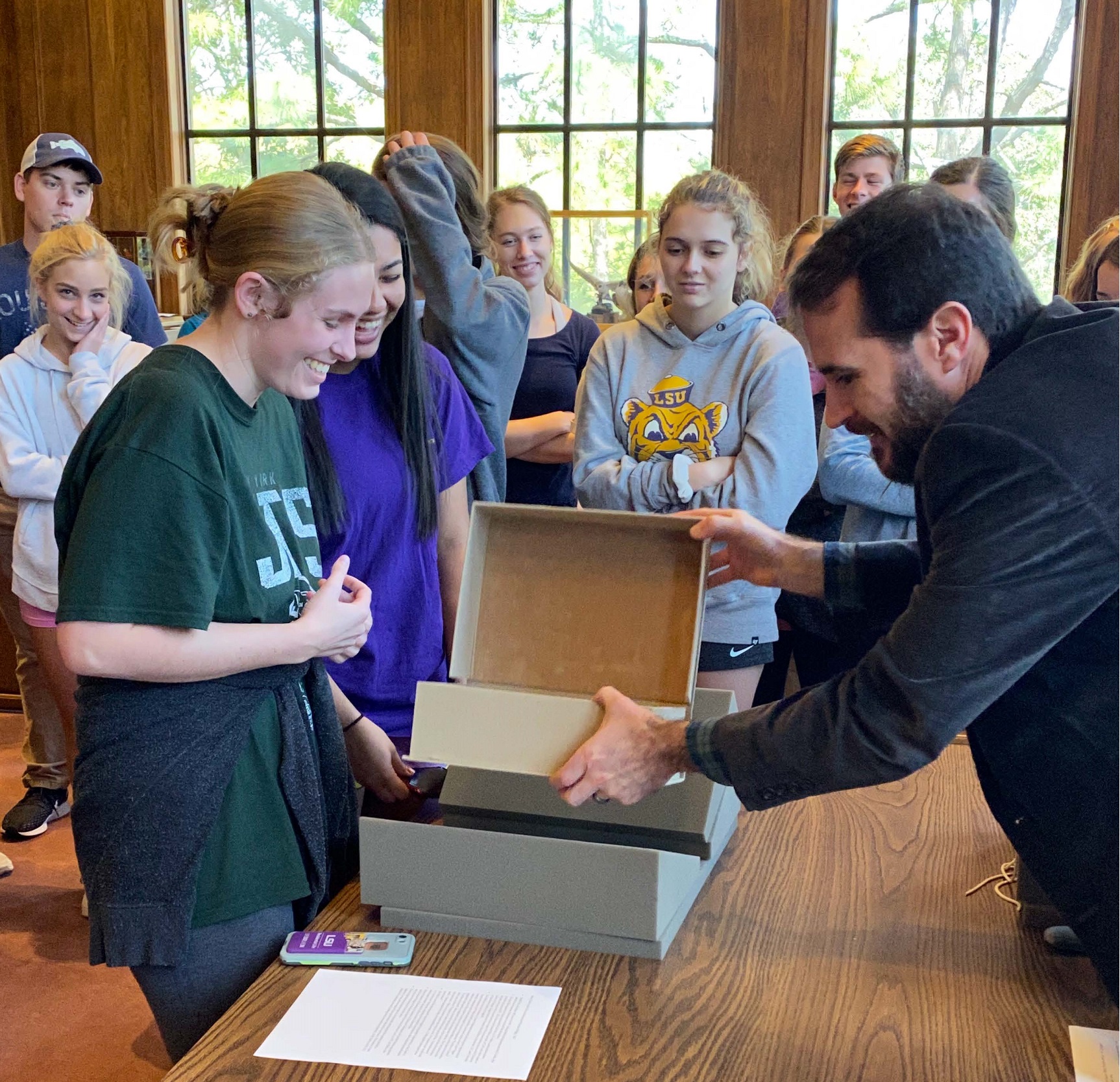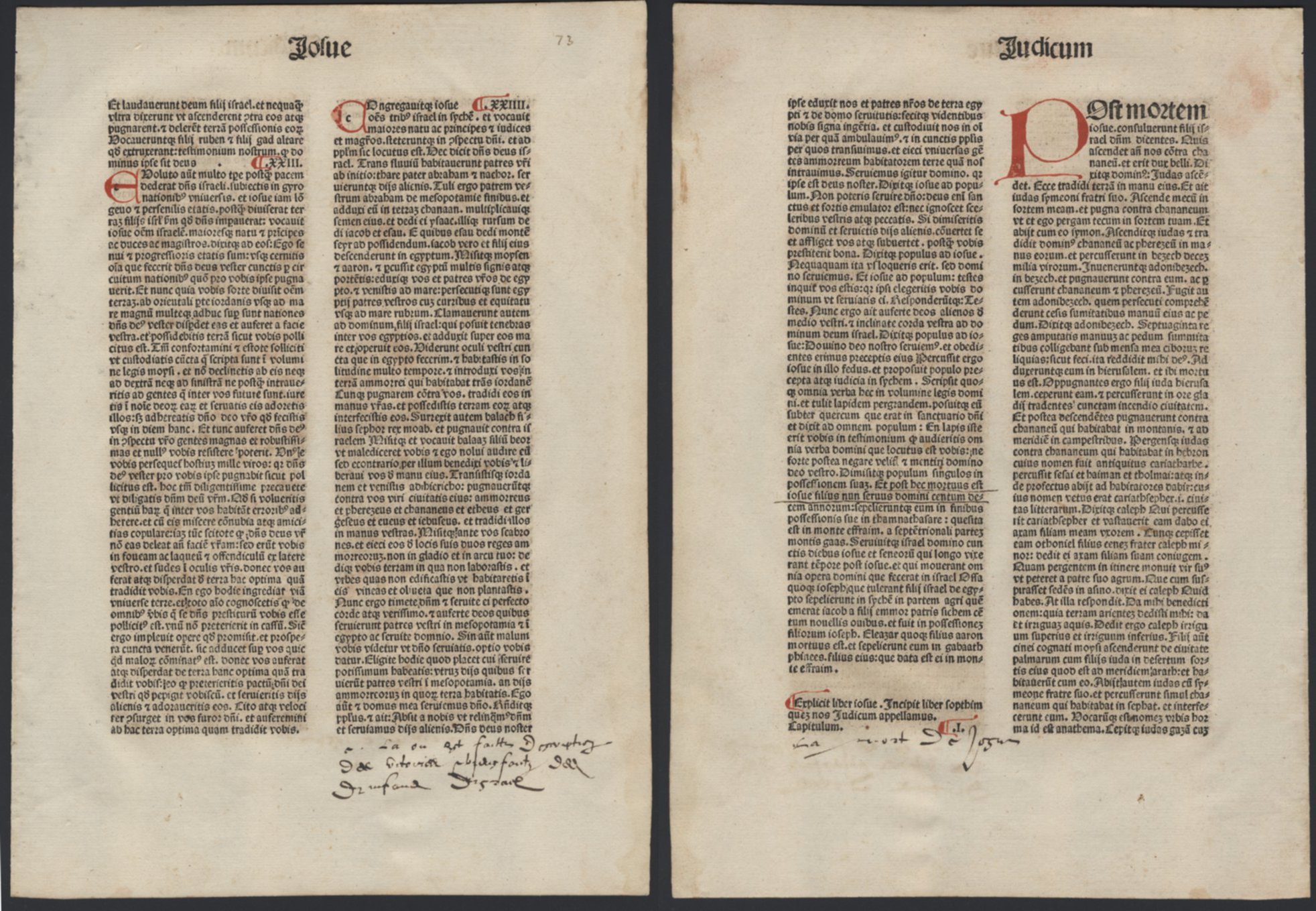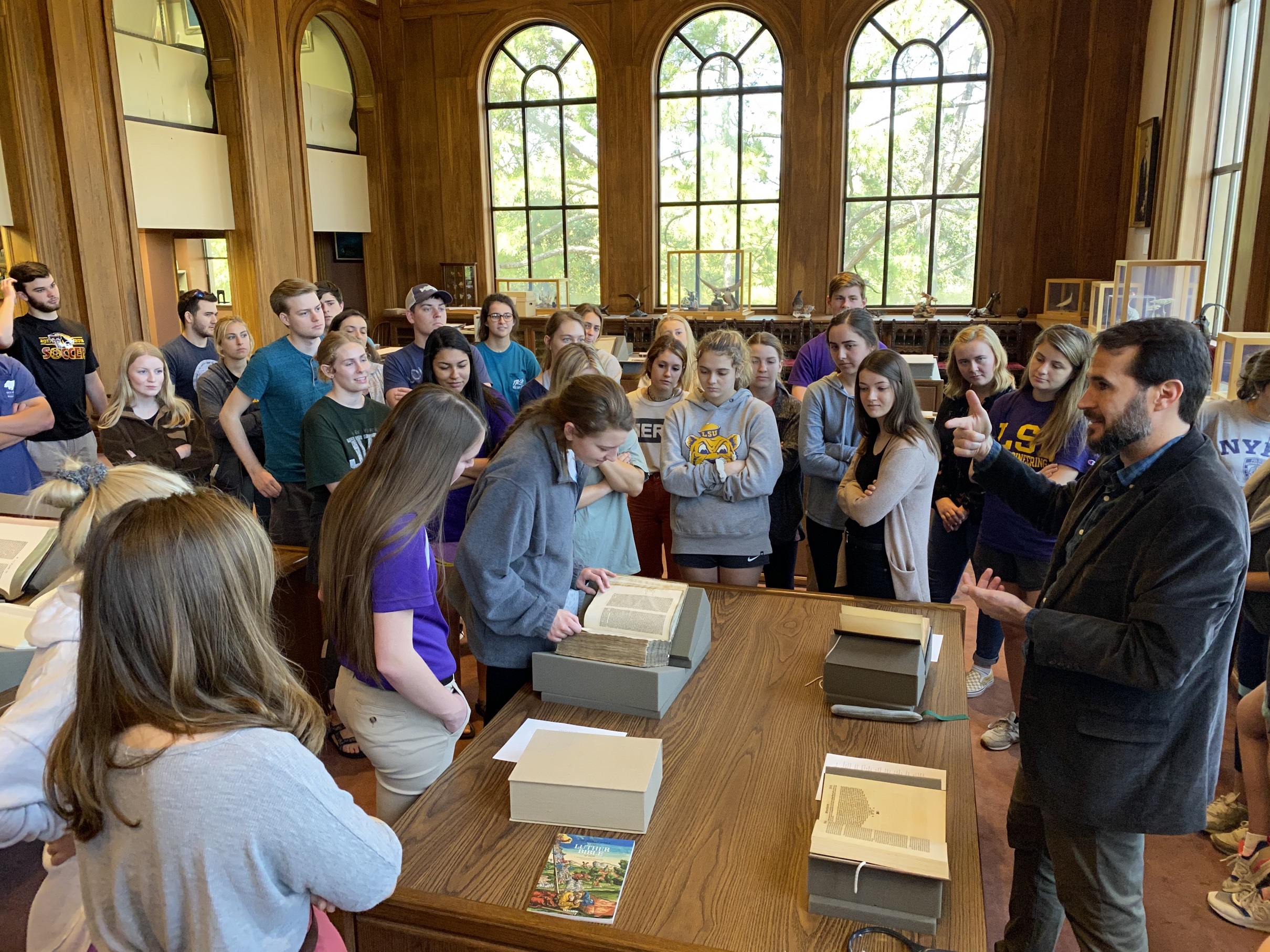This just in: A Bible from the late Middle Ages
As our days under lockdown turn to weeks and now months, it’s getting harder to remember a time when going to the library and physically touching books was a possibility, and the tactile experience of holding a material piece of the past seems to vanish into the pre-COVID mists. However, as a reminder of more innocent bygone days and in anticipation of our brave new future, let us take a brief look back to one of Special Collections’ last classes of the spring semester and the introduction of a recent donation.

On the morning following LSU Football’s National Championship, long-time supporter of the Libraries Tom Taylor contacted us and offered LSU yet another reason for celebration: a generous donation of books selected from his lavish collection. Leaping at the gracious and timely offer, we began making room in the stacks for the new arrivals and contacting interested professors to invite them to be a part of some of the books' unboxing. Just before the Libraries were shuttered for the semester the first donation made its debut in religion professor Bradley Storin’s class on the New Testament. This book is one of the most impressive of Taylor’s donation: a copy of the Bible in Latin printed in Lyons, France in 1482, less than thirty years after the printing of the Gutenberg Bible. This edition was printed by the partnership of Marcus Reinhart and Nicolaus Philippi and is only the third Bible printed in France. (The first such Bible was issued in Paris in 1477, followed by a publication in Lyons in 1479.) Remarkably, only three other complete copies of this edition are known to survive, two held in libraries in the United States and one in England.

The Bible’s text is that of the Swiss scholar Johann Amerbach’s revision of the Latin Vulgate, for which Amerbach compared the Vulgate to early Greek manuscripts, an example of the rigorous humanistic scholarship on the rise in the fifteenth century. The pages are adorned with hand-illustrated initial letters in blue and red. This technique, known as rubrication, was a holdover from hand-written manuscript books; the practice continued in a limited manner into the sixteenth century. In this way each copy of the book is unique, despite their printed text being the same. Alas, detailed photos of our copy of this book will have to wait until after campus reopens, but this leaf from Grand Valley State University’s Seidman Rare Book Collection gives a sense of the book’s evenly spaced two-column layout; Ohio University’s Special Collections also has an example. (In both cases these are single leaves -- two pages -- which have been preserved, and not the entire book.) Prior to Taylor’s donation, Special Collections’ oldest Bible was our copy of the Douai-Rheims bible, published by English Catholics in France in 1582 (the New Testament) and 1609-10 (the Old Testament). When this new addition has been fully catalogued and finds its home on our shelves it will extend our holdings of Bibles back one hundred years and into the early days of printing, known today as the incunable period. This Bible’s printed text and its hand-decorated initial letters form a bridge between early manuscript bibles, of which we hold many fine facsimile reproductions, and later printed works, represented by the Douai-Rheims Bible and our copy of the 1612/13 edition of the King James Bible.  Biblia latina, featuring the end of the book of Joshua and the beginning of Judges. We didn't have time to take good photographs of our copy before campus was closed, to this look is courtesy of Grand Valley State University's Seidman Rare Book Collection." data-title="An image of one leaf of the Biblia latina, featuring the end of the book of Joshua and the beginning of Judges. We didn't have time to take good photographs of our copy before campus was closed, to this look is courtesy of Grand Valley State University's Seidman Rare Book Collection." data-align="center"/> We will have this exciting new acquisition fully cataloged and available for viewing in our reading room… as soon as possible? Really, we couldn't be more anxious to get back to doing the work of making these kinds of objects available to the public and we will get back to doing so just as soon as it’s safe to return to the library. Once we do, and as soon as we all collectively shake off our quarantine cobwebs, an afternoon spent in our reading room paging through this impressive feat of early European printing might be just what eyes strained by too much screen-time need. More than just a physical comfort, some quality time with this particular book might also offer a spiritual salve, as it has been through many previous pandemics -- from the Bubonic Plague to Yellow Fever to the Spanish Flu -- and still stands as testament to humanity's dogged endurance and passionate search for knowledge. It is a lot for a single tome to shoulder, but the heft and craft of this Bible published ten years before Columbus sailed west from Spain is ready to bear just such a burden. Our thanks to Professor Storin and the students of his Religion 1005 class for helping us welcome this book into Special Collections, as well as kindest regards to Tom Taylor for his donation and his continued support of the mission of the Libraries and the betterment of the University community.
Biblia latina, featuring the end of the book of Joshua and the beginning of Judges. We didn't have time to take good photographs of our copy before campus was closed, to this look is courtesy of Grand Valley State University's Seidman Rare Book Collection." data-title="An image of one leaf of the Biblia latina, featuring the end of the book of Joshua and the beginning of Judges. We didn't have time to take good photographs of our copy before campus was closed, to this look is courtesy of Grand Valley State University's Seidman Rare Book Collection." data-align="center"/> We will have this exciting new acquisition fully cataloged and available for viewing in our reading room… as soon as possible? Really, we couldn't be more anxious to get back to doing the work of making these kinds of objects available to the public and we will get back to doing so just as soon as it’s safe to return to the library. Once we do, and as soon as we all collectively shake off our quarantine cobwebs, an afternoon spent in our reading room paging through this impressive feat of early European printing might be just what eyes strained by too much screen-time need. More than just a physical comfort, some quality time with this particular book might also offer a spiritual salve, as it has been through many previous pandemics -- from the Bubonic Plague to Yellow Fever to the Spanish Flu -- and still stands as testament to humanity's dogged endurance and passionate search for knowledge. It is a lot for a single tome to shoulder, but the heft and craft of this Bible published ten years before Columbus sailed west from Spain is ready to bear just such a burden. Our thanks to Professor Storin and the students of his Religion 1005 class for helping us welcome this book into Special Collections, as well as kindest regards to Tom Taylor for his donation and his continued support of the mission of the Libraries and the betterment of the University community.

